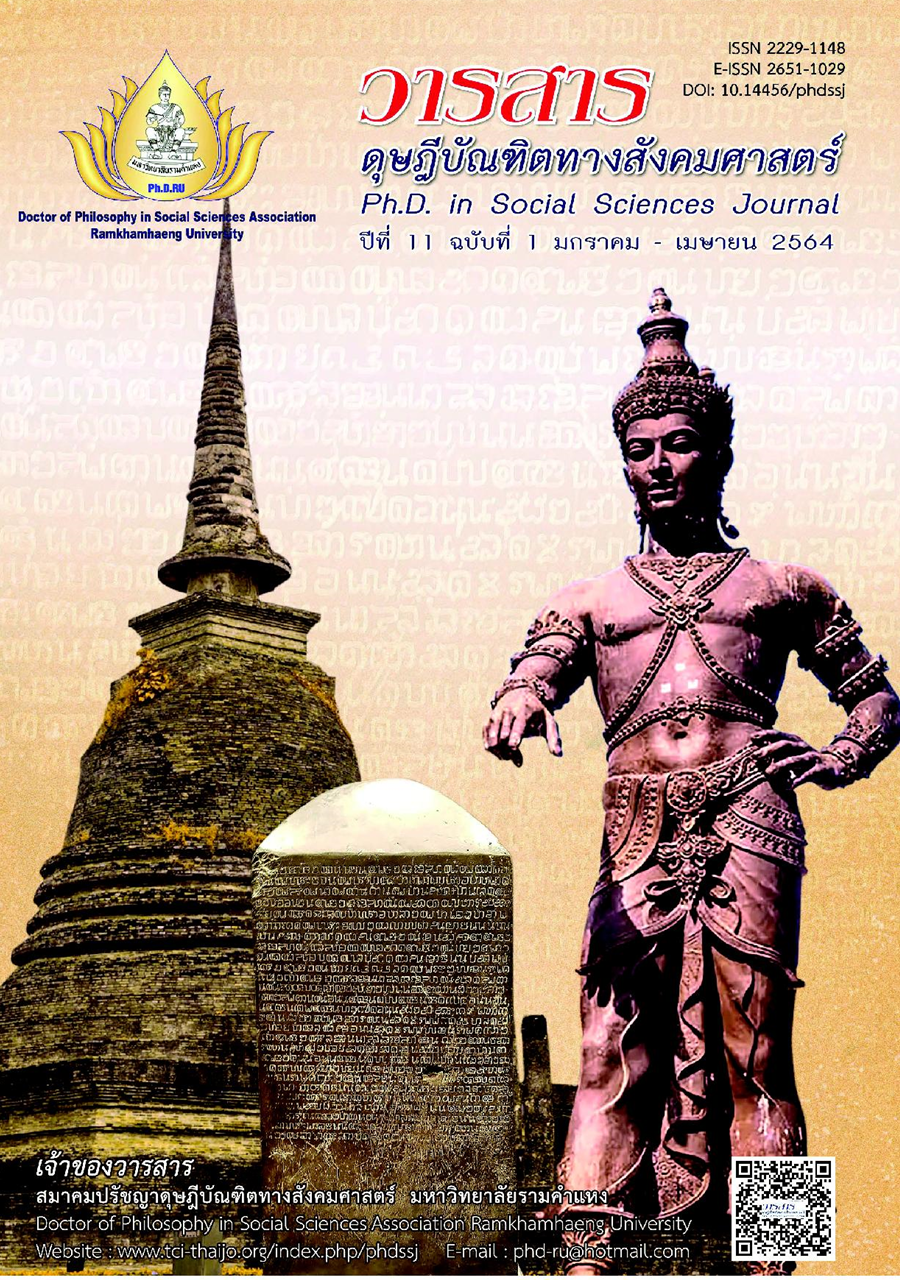ปัจจัยเชิงสาเหตุที่มีอิทธิพลต่อผลการดำเนินงานด้านการแข่งขันของผู้ประกอบการ ธุรกิจบริการขนส่งสินค้าทางถนนในประเทศไทย
Main Article Content
บทคัดย่อ
บทความวิจัยนี้ มีวัตถุประสงค์ (1) เพื่อตรวจสอบความสอดคล้องของตัวแบบกับข้อมูลเชิงประจักษ์ของปัจจัยที่มีอิทธิพลต่อผลการดำเนินงานด้านการแข่งขัน และ 2) เพื่อศึกษาอิทธิพลของปัจจัยที่มีอิทธิพลต่อผลการดำเนินงานด้านการแข่งขันของผู้ประกอบการธุรกิจบริการขนส่งสินค้าทางถนนในประเทศไทยโดยเก็บข้อมูลจากผู้ประกอบการธุรกิจบริการขนส่งสินค้าทางถนนในประเทศไทย จำนวน 390 ตัวอย่าง ใช้โปรแกรมคอมพิวเตอร์สำเร็จรูปในการวิเคราะห์องค์ประกอบเชิงยืนยันและสมการโครงสร้าง (Structure Equation Model--SEM)
ผลการวิจัย พบว่า (1) หลังจากใช้โปรแกรมสำเร็จรูปตรวจสอบความสอดคล้องของโมเดลสมการโครงสร้าง ปรากฏว่าดัชนีทุกตัวผ่านเกณฑ์มาตรฐาน ประกอบด้วย p-value =0.376, GFI = 0.976, AGFI = 0.963, CFI = 0.998, RMSEA = 0.011 และ RMR = 0.021 ดังนั้น จึงสามารถสรุปได้ว่าผลการวิเคราะห์ที่ได้ครั้งนี้สอดคล้องกับข้อมูลเชิงประจักษ์ และ (2) จากผลการวิเคราะห์เส้นทาง พบว่า ปัจจัยที่มีอิทธิพลต่อผลการดำเนินงานด้านการแข่งขันของผู้ประกอบการธุรกิจบริการขนส่งสินค้าทางถนนในประเทศไทย ประกอบด้วย ปัจจัยด้านภาวะผู้นำการเปลี่ยนแปลงปัจจัยด้านเทคโนโลยีสารสนเทศ และปัจจัยด้านกลยุทธ์การจัดการธุรกิจ โดยมีค่าอิทธิพลรวมเท่ากับ 0.550, 0.392 และ 0.426 ตามลำดับ อย่างมีระดับนัยสำคัญทางสถิติที่ 0.01 และพบว่าสามารถร่วมกันอธิบายผลการดำเนินงานด้านการแข่งขันของผู้ประกอบการธุรกิจบริการขนส่งสินค้าทางถนนในประเทศไทย ได้ร้อยละ 60.4 (R2 =0.604) งานวิจัยนี้สามารถใช้เป็นแนวทางในการดำเนินงานด้านการแข่งขันของผู้ประกอบการธุรกิจบริการขนส่งสินค้าทางถนนในประเทศไทย และธุรกิจที่มีลักษณะคล้ายคลึงกันในการสร้างความได้เปรียบทางการแข่งขันของธุรกิจ
Article Details
บทความวิชาการ บทความวิจัย และบทวิจารณ์หนังสือในวารสารดุษฎีบัณฑิตทางสังคมศาสตร์ เป็นความคิดเห็นของผู้เขียน มิใช่ของคณะผู้จัดทำ และมิใช่ความรับผิดชอบของสมาคมปรัชญาดุษฎีบัณฑิตทางสังคมศาสตร์ มหาวิทยาลัยรามคำแหง (กรณีการทำวิจัยในมนุษย์ ผู้วิจัยต้องผ่านการอบรมจริยธรรมการวิจัยในมนุษย์ และนำหลักฐานมาแสดง)
เอกสารอ้างอิง
Aaker, D. A. (1991). Managing brand equity: Capitalizing on the value of a brandname. Free Press.
Abdullah, N., & Yaakub, S. (2014). Reverse logistics: Pressure for adoption and the impact on firm’s Performance. International Journal of Business and Society, 15(1), 151-170.
Achua, C. F., & Lussier, R. N. (2010). Effective leadership. South-Western.
Angsuchoti, S., Wichitwanna,S., & Kunphinyopanuwat, R. (2014). Statistical analysis for research in social science and behavior science: techniques for using LISREL programs (3rd ed.). Charoen Munkong Dee. [In Thai]
Bunkwan, T., & Apisakul, A. (2012). Strategic management: Building and implement a strategy. McGraw-Hill. [In Thai].
Daugherty, P. J., Myers, M. B., & Richey, R. G. (2002). Information support for reverse logistics: The influence of relationship commitment. Journal of Business Logistics, 23(1), 85-107.
Department of Business Development. (2018). Number of Thai logistics service providers. Author. [In Thai].
Department of National Parks Logistics Division. (2019). Industrial logistics performance index: Key success factor. Author [In Thai].
Desai, D., Sahu, S., & Sinha, P. K. (2007). Role of dynamic capability and information technology in customer relationship management: A study of Indian companies. Vikalpa, 32(4), 45-59.
Duangphastra, C. (2017). Logistics management. McGraw-Hill. [In Thai].
Dutu, C. & Halmajan, H. (2011). The effect of organizational readiness on CRM and business performance. International Journal of Computers, 1(5), 106-114.
Field, A. (2005). Discovering statistics using SPSS (2nd ed.). Sage.
Frese, M. (2000). Success and failure of Mechlien Owners in Africa. Greenwood.
Gibson, M.. (1997). Nursing care of children (3rd ed.). Delmar.
Hair, J. F., Black, W. C., Babin, B. J., & Anderson, R. E. (2010). Multivariate data analysis: A global perspective. Prentice Hall.
Kasim, A. A., & Minai, B. (2009). Linking CRM strategy, customer performance measures and performance in the hotel industry. International Journal of Economics and Management, 3 (2), 297-316.
Laudon, K, C. & Laudon, J, P. (2015). Management Information technology. Prentice Hall.
Porter, M. E. (1980). Competitive strategy: Techniques for analyzing industries and competitors. Free Press.
Queiroz, J. P., & Oliveira, B. (2014). Benefits of the marketing information system in the clothing retail business. Journal of Information Systems and Technology Management, 11(1), 153-168.
Saglietto, L. (2013). Towards a classification of fourth party logistics (4PL). Universal Journal of Industrial and Business Management, 1(3), 104-116.
Silva, L. M. da., & Neto, J. S. (2014). Method for measuring the alignment between information technology strategic planning and actions of information technology governance. Journal of Information Systems and Technology Management, 11(1), 131-152.
Thai, V. V., Cahoon, S., & Tran, H. T.. (2011). Skill requirements for logistics professionals: Findings and implications. Asia Pacific Journal of Marketing and Logistics, 23(4), 553-574.
Theppitak, T. (2012). Readiness and adaptation of Thai logistics service branches towards the liberalization of trade in transport services by SMEs trucks. Burapha University, Faculty of Logistics. [In Thai]
Vonginta, T., Kuntasaat, A., & Charoensuk, G. (2018). Truck fleet and vehicle routing management by using the concept of integer linear programming with a case study of liquid product. Journal of Transportation and Logistics,11(1), 99-116. [In Thai]
Waldman, S. (2006). Stakeholder theory. Retrieved form http://www.csr-thai.blogspot.com [In Thai]
Yukl, G. A. (2010). Leadership in organizations (7th ed.). Prentice Hall.


